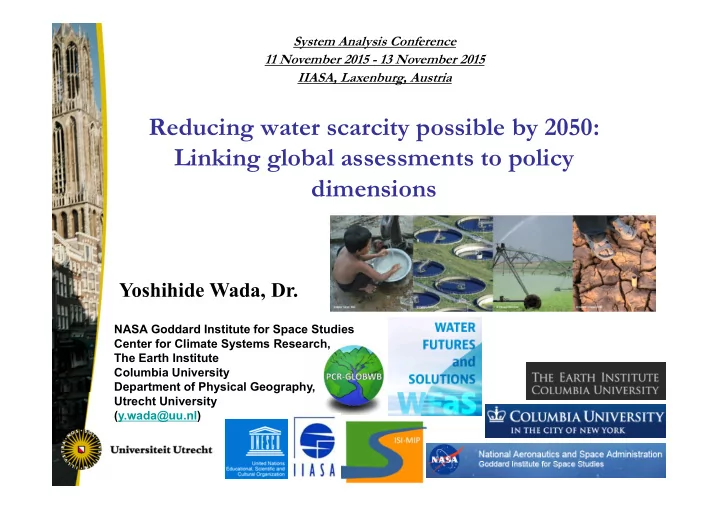

System Analysis Conference 11 November 2015 - 13 November 2015 IIASA, Laxenburg, Austria Reducing water scarcity possible by 2050: Linking global assessments to policy dimensions Yoshihide Wada, Dr. NASA Goddard Institute for Space Studies Center for Climate Systems Research, The Earth Institute Columbia University Department of Physical Geography, Utrecht University (y.wada@uu.nl) 1
Human Water Use 20th and Early 21st Century 2
Water Scarcity Index 1960 2000 Wada et al. (2011; WRR) 3
Human and Climate System - Water use : Agriculture: 60%, Industry: 30% and Households: 10% - Water scarcity since 1980s has been anthropogenically driven rather than climate induced. Water Scarcity 1986-1988 1991 1993 1995 2000 Romania WSI [-] with 4 Water use [km 3 /yr] Left axis: Right axis: Humans Climate
Is there enough water for all (humankind…)? and Will there be enough water? 5
Global Hydrological Model 6 Wada et al. (2014; Earth System Dynamics)
Water Futures and Solutions (WFaS) Consists of three major coalitions Sponsor Coalition Organized into the following groups ensuring consistency & usefulness of outputs Governing Board Science Stakeholder Coalition Coalition Sector Actors Group Scenario Focus Project Director Project Director Group WaterFutures4 the World Project Team External experts p Secretariat
About 30% of the global population currently lives with water stress. This fraction may increase up to about 50%. We present six strategies, or water-stress wedges, that collectively lead to a reduction in the population affected by water stress by 2050, despite an increasing population. Wada et al. (2014), Nature Geoscience, doi:10.1038/ngeo2241
Future projections: Climate and socio-economic change 13
Global change in future irrigation water demand RCP 2.6 RCP 4.5 RCP 6.0 RCP 8.5 Relative increase compared to the present-day condition (2000), i.e. mean of 1980-2010 % Global change by 2050 Wada et al. (2013; GRL)
Industry 3500 Historical Industrial water withdrawal RCP2.6 3000 RCP4.5 RCP6.0 2500 Water use intensity RCP2.6TECH km 3 yr -1 2000 RCP4.5TECH RCP6.0TECH 1500 Reference year: 2010 1000 1. Business-as-usual 500 scenario 0 No improvement 600 Historical Industrial water consumption RCP2.6 2. TECH scenario 500 RCP4.5 RCP6.0 400 RCP2.6TECH An improvement based on km 3 yr -1 RCP4.5TECH 300 energy consumption per unit RCP6.0TECH electricity production 200 (energy consumption intensity) 100 0 15
Households 2500 Historical Domestic water withdrawal RCP2.6 RCP4.5 2000 RCP6.0 Water use intensity RCP2.6TECH 1500 km 3 yr -1 RCP4.5TECH RCP6.0TECH Reference year: 2010 1000 500 1. Business-as-usual scenario 0 No improvement 1200 Historical Domestic water Consumption RCP2.6 2. TECH scenario 1000 RCP4.5 RCP6.0 800 RCP2.6TECH An improvement based on km 3 yr -1 RCP4.5TECH 600 energy consumption per unit RCP6.0TECH electricity production 400 (energy consumption intensity) 200 0 16
2010 Human water consumption Wada and Bierkens (2014; ERL) In cooperation with IIASA for WFaS project 2100 17
Relative change in human water consumption 2100 – 2010 18
Future water availability (2100) Schew et al. (2013) Relative change in annual discharge at 2 ° C compared with present day, under RCP8.5. Results analyzed for 5 climate models and 4 RCPs Schellnhuber HJ, Frieler K, Kabat P (Eds) (2014). Global Climate Impacts: A Cross-Sector, Multi-Model Assessment Special Feature. Proceedings of the National Academy of Water Futures Sciences (PNAS), 111(9):3225-3297 (4 March 2014)
2010 2050 20
Wedge approach to water stress Each solution = 2% reduction We present six strategies, or water-stress wedges, that collectively lead to a reduction in the population affected by water stress by 2050, despite an increasing population. - Water productivity – crop per drop - Irrigation efficiency – decrease losses - Water use intensity – industry and domestic Hard path vs. Soft path - Population - Reservoir storage - Desalination Wada et al. (2014), Nature Geoscience
Different basins lend themselves to different measures for reducing water stress: Agricultural water productivity , Irrigation efficiency , Improvements in domestic and industrial water-use intensity , Limiting the rate of population growth, Increasing water storage in reservoirs , Desalination of seawater Wada et al. (2014), Nature Geoscience, doi:10.1038/ngeo2241
Improvement in water productivity at 0.5% per year (20% by 2050) Efficiency increase by 1% per year (40% by 2050) Improvement Limit population growth by of 0.5% per year 0.5 billion 23 (20% by total) (8.5 billion by 2050)
Additional 600 km 3 reservoir storage (by 2050) 50 times increase in desalination capacity (by 2050) 24
WFaS approach - Significant reductions in the number of people that live with water stress are possible by 2050, compared with a business-as-usual situation. - Water availability and use are inherently regional concerns. However, a global-scale approach to evaluating strategies to reduce water stress can help maximize mitigation. - A strong commitment and strategic efforts are required to make the solutions happen. - Economic and environmental costs need to be considered. - Stronger link to food and energy sector. 25
Recommend
More recommend